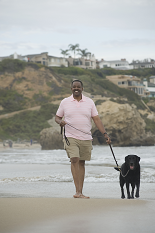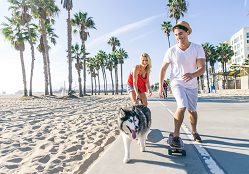


Tips to Keep Your Pets Safe
in the Heat
Whether your pet stays indoors or outdoors, it is
important to keep them safe from the summer heat. Learn
more about how to protect your pet when the temperature
rises.
Quick
Tips: How to Keep Pets Safe and Healthy in the Heat  English /
Spanish
English /
Spanish

Heat Stress in Pets
Excessive panting,
drooling, weakness, and
reluctance to move in a
pet may be caused by
heat stress. It can
also cause vomiting,
diarrhea, seizures.
Heat stroke can be
life-threatening in a
pet. If you see any of
these signs, take your
pet to a veterinarian
immediately.
Some pets are at higher
risk - pets with short
noses or long hair, pets
that are older, obese,
or have heart or lung
disease are more likely
to overheat.
Talk with your
veterinarian about
heat risks for your pet. |

NEVER LEAVE YOUR PET ALONE IN A PARKED CAR!
Even if the windows are 'cracked' or open.
-
On an 85°F day, a car’s temperature can
reach 100°F in less than ten minutes.
-
Always look before you lock!
Cooling Centers
- In extreme heat,
cooling
centers will be
activated around the
County of Los Angeles.
-
Call the cooling center before you go to
check if pets are permitted.
-
Call 2-1-1 for an
updated list of cooling
centers in Los Angeles
County or click
here
-
Call 3-1-1 for an updated list of
cooling centers in the City of Los
Angeles or click
here
Give Your Pets Everything They Need for the Heat
-
Water.
Make sure your pet has access to clean, cool water at all times.
-
Shade.
If your pet is kept outdoors, provide
them with plenty of shade.
-
Grooming.
Pets with long fur can more easily
overheat.
-
Brush pets more
frequently to remove
excess hair and help
them feel cooler.
-
Ask your groomer or
veterinarian about
trimming your pets coat
short for the summer.
-
Some pets may have very
thin/patchy fur, or may
not have any fur at all.
These pets are at a
higher risk of getting a
sunburn. Sunscreen
labeled for pet use may
be applied to protect
their exposed skin.
Safe Exercise and Play with Your Pet in the Heat
-
Choose the morning or evening hours when
it’s cooler out to walk or
exercise your pet.
-
Take frequent breaks
to make sure your pet is not
overheating; do not force your pet to
continue if they need to rest.
-
Bring
enough drinking water for both you and
your pet.
-
Feel the ground before your pet
walks on it. The ground
gets hotter than the air. Avoid
surfaces like asphalt that may burn your
pet’s paws.
-
Always supervise pets near
pools or bodies of water.
Wash your pet after swimming to remove
excess chlorine, salt, or other
chemicals. Do not let your pet drink
from a pool, ocean, lake, or river.
Additional Resources:
Summer Weather Tips - Los Angeles County Department
of Animal Care and Control
Last updated: June 15, 2021